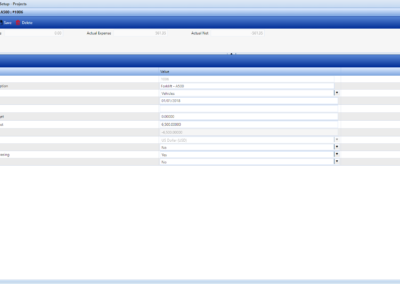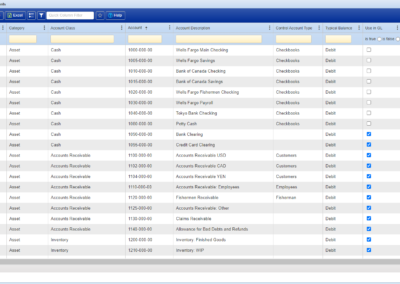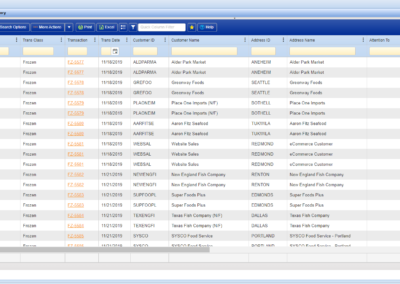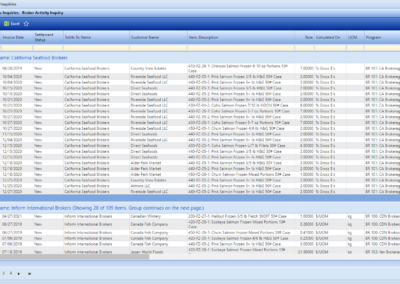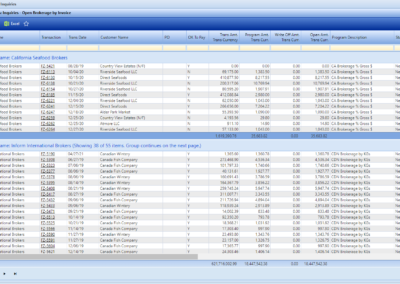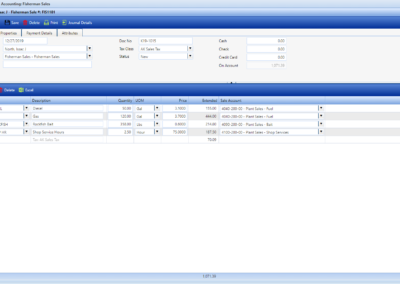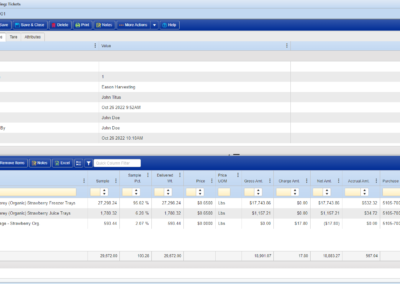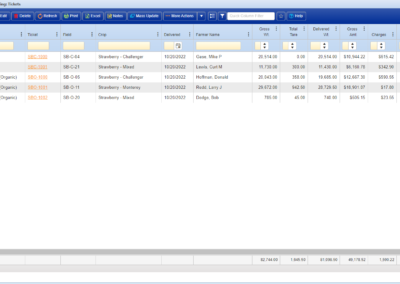NorthScope ERP Features
Integrated features that work together to help enhance your food manufacturing business.Functional Areas
Key Features
Accounting
The base accounting features include General Ledger, Accounts Payable, Accounts Receivable, and Bank Reconciliation.
The General Ledger tasks include configuring the chart of accounts, entering manual journal entries, maintaining the fiscal calendar, running the year end close, and printing financial reports. The General Ledger is updated as transactions are posted from Accounts Payable, Accounts Receivable, Fisherman Accounting, Grower Accounting, Inventory, Purchasing, Sales, and Sales Program Settlements.
The Accounts Payable tasks include configuring and maintaining vendor data, importing and/or entering AP Invoices, building payment batches, and managing vendor aging. Accounts Payable integrates with the General Ledger, Fisherman Accounting, Grower Accounting, Brokerage, and Rebates.
The Accounts Receivable tasks include configuring and maintaining customer data, entering debit & credit memos, receiving & applying customer payments, and managing customer aging. Accounts Receivable integrates with the General Ledger, Sales Order, Brokerage and Rebates.
The Bank Reconciliation tasks include configuring checkbooks, entering account transfers, entering bank transactions, and reconciling bank statements. Bank Reconciliation integrates with the General Ledger, Accounts Payable, and Accounts Receivable.
- General Ledger
- Journal Entries
- Journal Entry Import
- Fiscal Period Management
- Month-End Close
- Year-End Close
- Project Tracking
- Financial Reporting
- Configurable GL Account Format
- Detailed GL Posting from Every Transaction
- Flexible Reporting & Inquiries with Drill-Through to Transactions – Watch Video
- Accounts Payable
- AP Invoices & Credit Memos
- Purchase Order Integration
- Quick Visibility of Current Vendor Balances
- Historical Vendor Aging
- Flexible AP Check Batches & Manual AP Checks
- Vendor Maintenance with User-Defined Attributes
- Configurable Transaction Classes
- User-Defined Fields Unique to each Transaction Type
- Safe Pay & Direct Deposit (ACH) for Vendors
- Applying & Unapplying of Historical Payments & Credit Memos
- Voiding of Historical Transactions
- PaperVision (Document Management Software) Integration
- Flexible Reporting & Inquiries with Drill-Through to Transactions
- Accounts Receivable
- Robust Customer Management
- Quick Visibility of Current Customer Balances
- Historical Customer Aging
- Credit Limit Management
- Cash Receipts to Record Customer Payments
- User-Defined Fields Unique to each A/R Transaction Type
- Applying & Unapplying of Historical Payments & Credit Memos
- Flexible Reporting & Inquiries with Drill-Through to Transactions
- Bank Reconciliation
- Bank Reconciliation
- Deposit, Transfer, and Adjustment Transactions
- General Ledger
- Import or Enter Manual Journal Entries
- Import or Enter Accrual Entries
- Post Multiple Journal Entries at the Same Time
- Correct Historical Journal Entries
- Void Historical Journal Entries
- Month-End Close
- Year-End Close
- Reverse & Correct Previous Year-End Close
- Maintain Chart of Accounts with Posting Rules
- Manage Project Entries for Capital Projects and/or Equipment
- Accounts Payable
- Import or Enter AP Invoices & Credit Memos
- Post Multiple Transactions at the Same Time
- Void AP Checks, Invoices & Credit Memos
- Apply Payables
- Build AP Check Batches or Manual Checks
- Process Direct Deposit (ACH) Payments
- Generate Safe Pay File
- Distribute Fishermen Charges on Invoices
- Review Vendor Balances & Aging
- Accounts Receivable
- Accounts Receivable Sale Transactions
- Cash Receipts
- Apply Receivables
- Review Customer Balances & Aging
- Bank Reconciliation
- Reconcile and record deposits, transfers and adjustments to your checkbooks
- General Ledger
- ACH Batch History – View Inquiry
- Beginning Balances – View Report
- GL Account Balances by Period- View Inquiry
- GL Account Balances – View Inquiry
- Journal Entry History – View Inquiry
- Journal Line History – View Inquiry
- Ledger Account Detail –View Report
- Project Transaction History – View Inquiry
- Trial Balance – View Report
- Accounts Payable
- Invoice History – View Inquiry
- Invoice Line History- View Inquiry
- Payment Application History –View Inquiry
- Vendor Aging – View Report
- Vendor Balances –View Inquiry
- Vendor History Inquiry – View Inquiry
- Accounts Receivable
- Billing History – View Inquiry
- Customer Aging – View Report
- Customer Balances – View Inquiry
- Payment Receipt History – View Inquiry
- Sales Item History – View Inquiry
- Sales Transaction History – View Inquiry
- Bank Reconciliation
- Checkbook Reconciliation – View Inquiry
- Checkbook Register – View Inquiry
- Outstanding Transactions by Checkbook – View Report
- Undeposited Receipts –View Report
- General Ledger
- Fiscal Periods
- GL Account Class
- GL Account Format
- GL Accounts
- Preferences
- Project Class
- Projects
- Statistical Accounts
- Accounts Payable
- Aging Periods
- Payment Terms
- Preferences
- Transaction Class
- Vendor Class
- Vendors
- Vendor Addresses
- Vendor ACH
- Accounts Receivable
- Aging Periods
- Customer Class
- Customers
- Customer Addresses
- Payment Terms
- Preferences
- Transaction Class
- Tax Class
- Tax Details
- Bank Reconciliation
- Checkbooks
Brokerage
Brokerage programs are used to compute, accrue, and pay brokerage commissions to outside vendors. Brokerage Programs are automatically added to eligible Sales Transactions. When a sale transaction containing one or more Brokerage Programs is posted, the accrued brokerage amounts post to the General Ledger as part of the sales journal entry, and the Brokerage details are added to the Brokerage subledger. Open Brokerage can be processed in bulk or by individual Broker as needed. Brokerage is fully integrated with General Ledger, Accounts Payable, Accounts Receivable and Sales Order.
- Easily configurable Brokerage programs
- Calculate Brokerage amounts as:
- $/UOM: (e.g., $1.25 / Lbs)
- % Gross Amount: (e.g., 2% of the gross item amount)
- % (Gross – Freight): (e.g., 2% Less included/estimated delivered freight)
- Automate calculation on Sales Orders
- Quick visibility of current Broker balances
- Historical Broker Aging
- Flexible reporting & inquiries with drill-through to transaction
- Configure and maintain Brokerage programs
- View Broker balances
- Process Brokerage Settlements
- Edit open Brokerage amounts
- Write off open Brokerage amounts
- Broker Activity – View Inquiry
- Open Brokerage by Invoice – View Inquiry
- Broker Programs
- Address Sets
- Item Sets
- Preferences
- Program Classes
Fisherman Accounting
The Fisherman Accounting functional area is used for buying fish, crab, or lobster directly from fishers, selling bait, fuel, and supplies. Fish Taxes are automatically applied to Fish Tickets and Premiums can be automated or manually assigned. The main tasks performed include importing or entering Fish Tickets, paying/settling accounts, managing fisherman balances, and managing fisherman loans. Fisherman Accounting integrates with the General Ledger, Inventory, and Accounts Payable.
- Fisher, Tender & Loan Management
- Fish Ticket management that includes:
- eLandings Integration – Watch Video
- Automated Fish Ticket Taxes
- Automated or manual Premiums
- Fish Ticket Price List Management – Watch Video
- Fish Ticket repricing & corrections, in bulk or by single ticket.
- Sales to Fishers, Tenders, & Customers
- Sales Tax Management
- Manage sales between Tenders and your fishers
- Sales Price List Management
- Charge Fisher accounts directly from Accounts Payable invoices, in one step
- Fisher Settlements (payments)
- Settle fishers individually or in a batch
- Settle using transaction balances or as needed
- Split Fisher payments (e.g., crew payments)
- Pay via Check or ACH
- Safe Pay integration
- Installs with ADF&G Master File Data
- User-Defined Fields Unique to each Transaction Type
- Configurable Transaction Classes
- Flexible Reporting & Inquiries with Drill-Through to Transactions
- Tickets
- Import Fish Tickets from eLandings
- Edit & Post Fish Tickets
- Reprice Fish Tickets (individually or in bulk)
- Reprice Fish Ticket Premiums in Bulk (individually or in bulk)
- Void & Correct Historical Fish Tickets
- Apply Chum %
- Fisher Accounts
- Adjustment Fisher, Tender or Loan Balances
- Transfer balances between Fishers, Tenders & Loans
- Receive and apply payments from Fishers, Tenders & Loans
- Sales
- Record Sales to Fishers using a Fisherman Sale transaction
- Record transactions Between Tenders & Fishers using a Tender re-sale transaction
- Process Settlements/Payments to Fishers
- Send out checks or upload ACH file to bank
- Split Fisher payments as needed
- Generate Safe Pay File
- Charge interest to Fisher Loans
- Maintain Price Lists for Fish Ticket and Sales
- Configure & Maintain Fish Ticket Taxes & Premiums
- Configure & Maintain Sales Tax Rules for Sales to Fishermen
- View Fisherman Balances
- Distribute Fisher Statements and other reports as needed
- Charge Fisherman Directly from AP Invoices
- Reports
- Buyer Deliveries –View Report
- City Sales Tax – View Report
- Fisherman Aging – View Report
- Fisherman Ranking – View Report
- Fisherman Statement – View Report
- Ticket Pricing History – View Report
- Ticket Purchases – View Report
- Inquiries
- Adjustment Line History – View Inquiry
- Balance Transfer Line History – View Inquiry
- Fisherman Sale History –View Inquiry
- Fish Ticket History – View Inquiry
- Fish Ticket Item History – View Inquiry
- Fisherman Transactions – View Inquiry
- Payment Receipt History – View Inquiry
- Ticket Line Stat Area History –View Inquiry
- Chill Type
- Conditions
- Dispositions
- Fish Ticket Items
- Fish Ticket Premiums
- Fish Ticket Taxes
- Fisherman ACH
- Fisherman Class
- Fishermen & Tenders
- Fishermen & Tender Addresses
- Gear
- Grades
- Loans
- Loan Addresses
- Management Programs
- Ports
- Preferences
- Price Lists
- Seasons
- Sites
- Species
- Stat Areas
- Tax & Premiums Classes
- Tax Class
- Tax Details
- Ticket Class
- Vessels
Grower Accounting
The Grower Accounting functional area is used to manage grower receipts for row crops, nuts, and farmed fish. The main tasks performed include entering and grading grower receipts and paying growers, harvesters, and haulers. Grower Accounting integrates with the General Ledger, Accounts Payable and Inventory functional areas.
- Grower Receipts / Delivery Tickets
- Price Lists for Grower Receipts
- Manage Company-Owned & 3rd Party product deliveries
- Automatic GL Accruals
- Automatic Charges/Deductions to Farmers
- Repricing & correcting of grower receipts
- Scale Integration
- Grower Balances & Payments via AP and/or ACH
- Inventory Integration
- User-Defined Fields
- Configurable Ticket Classes
- Flexible Reporting & Inquiries with Drill-Through to Transactions
- Input Grower Receipts / Delivery Tickets
- Post Multiple Grower Receipts at the Same Time
- Automate Inventory Receipts from Posted Grower Receipts
- Reprice & Correct Historical Tickets
- Configure & Maintain Ticket Charges, Taxes & Accruals
- Manage Company-Owned and/or 3rd Party Farms/Growers
- Maintain Price Lists for Grower Receipts
- View Grower Balances and Process Payments
- Generate Safe Pay File
- Grower Receipt
- Ticket History Inquiry
- Ticket Line Inquiry
- Accruals
- Charges
- Crops
- Farmers
- Fields
- Harvesters
- Haulers
- Hold Codes
- Preferences
- Price Lists
- Ticket Classes
- Ticket Items
Inventory
The Inventory functional area is used to configure Items and Sites, maintain perpetual inventory balances, maintain costing, provide lot tracing, and manage Production. The main tasks include maintaining the Item Master and entering and/or importing all inventory transactions. Inventory integrates with the General Ledger, Fisherman Accounting, Grower Accounting, Purchasing, Sales Order, Brokerage, and Rebates.
- Item Setup & Maintenance
- Perpetual Item Balances by Item and/or Lot – Watch Video
- Current & Historical Perpetual Product Balances
- Support for Unlimited Product Sites/Warehouses
- Support for Third Party Warehouse Lots
- Costing – Actual, Standard, and/or Market
- Lot Traceability & Recall
- Separation of Inventory by Product Owner
- Unique Transactions for Adjustments, Production, Receipts and Transfers
- Cycle Counts
- Hold Codes
- UOM Conversions
- Catch Weight/Variable Weight Item Management
- Lot Certifications
- Robust & Flexible Item Configuration
- Barcode Integration
- Voiding & Correcting of Historical Transactions
- Bill of Materials
- Configurable Transaction Classes
- Insured Value Price Lists
- Configurable Preferences for Setting Defaults and Turning Features On/Off
- User-Defined Fields Unique to each Transaction Type
- Enter Adjustment, Production, Transfer & Receipt Transactions with Item & Lot details
- Import inventory transactions from data collection devices
- Manage Delivered Freight (for Transfers) to generate freight accruals and/or freight purchase orders
- Record Export Details and Container information for International Transfers
- Post Multiple Transactions at the Same Time
- Correct Historical Transactions
- Void Historical Transactions
- Item Setup & Maintenance
- Manage Item Balances
- Manage Lot Balances
- Cycle Counts
- Maintain “Insured Value” Item Prices
- Mass Update Lot Properties, Production Batches, Bill of Materials, BOM Items & Quality Test Results
- Pallet Configuration
- Record Quality Test Results
- Update Costs
- Container Details
- Cost History
- Inventory As Of – View Inquiry
- Inventory Rollover – View Report
- Item Balances – View Inquiry
- Lot Balances – View Inquiry
- On Hand Inventory Balances – View Report
- Quality Test Results
- Transaction History – Item – View Inquiry
- Transaction History – Lot – View Inquiry
- General
- Carriers
- Cost Groups
- Freight Terms
- Hold Codes
- Item Class
- Items
- Pallet Configuration
- Preferences
- Price Lists
- Sites
- Transaction Class
- Units of Measure
- Manufacturing & Production
- Bill of Materials
- Production Orders
- Lot Tracing & Quality Assurance
- Country of Origin
- Lot Certifications
- Lot Owners
- Production Batches
- Warehouse Lots
- Quality Test Results
Purchase Order
Purchase Orders are used to manage pre-arranged purchase agreements with vendors. Purchase Orders integrate with the General Ledger, Projects, Accounts Payable, Costing, Fisherman Accounting, and Inventory Receipts. Purchase orders can also be used distribute charges to Fishermen, Tenders, or Projects or to identify line-items whose amounts are to be allocated to inventory cost.
- Purchase Order Entry
- Automatic Closure of Purchase Orders
- Autofill Purchase Order Items on linked AP Invoices and/or Inventory Receipts
- Multi-Vendor Purchase Orders by Line Item
- Single or multiple receipts and invoices against a Purchase Order
- Charge Purchase Order Lines directly to Fisher Accounts
- Close Multiple Purchase Orders at One Time
- Reopen Closed Purchase Orders
- View Purchase Order Balances
- Charge Purchase Order Lines directly to Fishers and/or Projects
- Enter a Single Purchase Order with Multiple line-item Vendors
- PO Linked Lines – View Inquiry
- PO Linked Transactions – View Inquiry
- Purchase Order History – View Inquiry
- Purchase Order Lines History – View Inquiry
- Payment Terms
- Preferences
- Transaction Class
- Vendor Class
- Vendors
- Vendor Addresses
Rebates
Rebate programs are used to compute, accrue, and process rebate amounts that can either be credited back to the customer or paid out to a Vendor (e.g., buying group, Sysco House, etc.). Active Rebate Programs are automatically added to eligible Sales Transactions. When a sale transaction that contains one or more Rebate Programs is posted, the accrued rebate amounts post to the General Ledger as part of the sales transaction journal entry and the Rebate details are added to the Rebates subledger. Open Rebates can be processed/settled by batch (to create one or more AR Credits and/or AP Invoices), as part of the payment receipt application process, or cancelled/written off. Rebates are fully integrated with General Ledger, Accounts Payable, Accounts Receivable and Sales Order.
- Rebate Management
- Easily configurable Rebate programs
- Easily configurable Off Book Rebate programs that auto calculate but do not accrue to the General Ledger until they are taken
- Calculate Rebate amounts as:
- $/UOM: (e.g., $1.25 / Lbs)
- % Gross Amount: (e.g., 2% of the gross item amount)
- % (Gross – Freight): (e.g., 2% Less included/estimated delivered freight)
- Automate Sales Order accruals
- Quick visibility of current Rebate balances
- Process accrued Rebates to either Accounts Payable or as Accounts Receivable credits
- Configure and maintain Rebate programs
- View open Rebate Program balances
- Process Rebate Settlements to either Accounts Receivable or Accounts Payable
- Edit open Rebate amounts
- Write off open Rebate amounts
- Rebate History
- Open Rebates by Invoice
- Rebate Programs
- Address Sets
- Item Sets
- Program Classes
Sales Order
The Sales functional area is used to manage the workflow of all Sales transactions including Orders, Price Adjustments, Returns, and Debit/Credit Memos. The main tasks include entering and/or importing sales transactions, allocating inventory to orders, managing customer price lists, and maintaining customer contracts. Sales Order integrates with the General Ledger, Fisherman Accounting, Inventory, Load Management, Brokerage, and Rebates.
- Sales Order entry, allocation, and Invoicing
- Sales Quotes
- Price Adjustments Against Historical Transactions
- Returns Against Historical Transactions
- Sales Order Workflow
- Delivered Freight Management
- Configurable Order Entry Rules
- Configurable Transaction Classes
- Credit Limit Management
- Support for Multiple Shipments Against a Single Order
- Support for Multiple Orders on One Shipment
- Price List Management
- Sales Contracts
- Robust Customer Management
- User-Defined Fields Unique to Each Transaction Type
- Export Details to support International Shipments
- EDI Integration
- Bar Code Integration
- Configurable Preferences for Setting Defaults & Turning Features On/Off
- Sales Order Entry
- Quote Entry
- Price Adjustment Entry
- Return Entry
- Debit/Credit memo Entry
- Allocate Inventory to Orders
- Review Inventory Allocations from Bar Code System
- Mass Update Status & Workflow of Transactions
- Ship Sales Orders
- Sales Order Invoicing / Billing
- Record Shipment Details Including Delivered Freight Expense
- Post Multiple Transactions at the Same Time
- Manage Customer Order Item Substitution Rules
- Maintain Sales Order Price Lists
- Mass Update Prices Across Multiple Price Lists
- View Customer Balances
- Void Sales Transactions
- Billing History – View Inquiry
- Container Details – View Inquiry
- Customer Activity – View Inquiry
- Price List History – View Inquiry
- Quick Sales – View Inquiry
- Quick Sale Lines – View Inquiry
- Sales Item History – View Inquiry
- Sales Shipment History – View Inquiry
- Sales Transaction History – View Inquiry
- Sales Data Warehouse – View Inquiry
- Carriers
- Contracts
- Freight Terms
- Hold Codes
- Preferences
- Price Lists
- Salespersons
- Sites
- Status Setup
- Transaction Class
- Workflow







